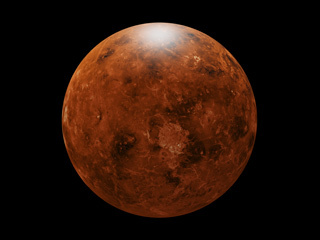Overview
The team also revealed the origins of this structure using large-scale climate simulations. The group was led by Project Assistant Professor Hiroki Kashimura (Kobe University, Graduate School of Science) and these findings were published on January 9 in Nature Communications.
Second planet from the Sun and our closest planetary neighbor, Venus is similar in structure and size to Earth, but it is now a very different world. Venus spins slowly in the opposite direction most planets do. Its thick atmosphere traps heat in a runaway greenhouse effect, making it the hottest planet in our solar system—with surface temperatures hot enough to melt lead. Glimpses below the clouds reveal volcanoes and deformed mountains.
Venus In Depth
Venus is the second planet from the Sun and our closest planetary neighbor. Similar in structure and size to Earth, Venus spins slowly in the opposite direction from most planets. Its thick atmosphere traps heat in a runaway greenhouse effect, making it the hottest planet in our solar system with surface temperatures hot enough to melt lead. Glimpses below the clouds reveal volcanoes and deformed mountains.
Venus is named for the ancient Roman goddess of love and beauty, who was known as Aphrodite to the Ancient Greeks.
Venus's Temperature
The average temperature on Venus is 864 degrees Fahrenheit (462 degrees Celsius). Temperature changes slightly traveling through the atmosphere, growing cooler farther away from the surface. Lead would melt on the surface of the planet, where the temperature is around 872 F (467 C).

Size and Distance
With a radius of 3,760 miles (6,052 kilometers), Venus is roughly the same size as Earth — just slightly smaller.
From an average distance of 67 million miles (108 million kilometers), Venus is 0.7 astronomical units away from the Sun. One astronomical unit (abbreviated as AU), is the distance from the Sun to Earth. It takes sunlight 6 minutes to travel from the Sun to Venus.
Orbit and Rotation
Venus' rotation and orbit are unusual in several ways. Venus is one of just two planets that rotate from east to west. Only Venus and Uranus have this "backwards" rotation. It completes one rotation in 243 Earth days — the longest day of any planet in our solar system, even longer than a whole year on Venus. But the Sun doesn't rise and set each "day" on Venus like it does on most other planets. On Venus, one day-night cycle takes 117 Earth days because Venus rotates in the direction opposite of its orbital revolution around the Sun.
Venus makes a complete orbit around the Sun (a year in Venusian time) in 225 Earth days or slightly less than two Venusian day-night cycles. Its orbit around the Sun is the most circular of any planet — nearly a perfect circle. Other planet's orbits are more elliptical, or oval-shaped.
With an axial tilt of just 3 degrees, Venus spins nearly upright, and so does not experience noticeable seasons.
Structure
Venus is in many ways similar to Earth in its structure. It has an iron core that is approximately 2,000 miles (3,200 kilometers) in radius. Above that is a mantle made of hot rock slowly churning due to the planet's interior heat. The surface is a thin crust of rock that bulges and moves as Venus' mantle shifts and creates volcanoes.
Formation
When the solar system settled into its current layout about 4.5 billion years ago, Venus formed when gravity pulled swirling gas and dust together to form the second planet from the Sun. Like its fellow terrestrial planets, Venus has a central core, a rocky mantle and a solid crust.

Kid-Friendly Venus
Even though Venus isn't the closest planet to the Sun, it is still the hottest. It has a thick atmosphere full of the greenhouse gas carbon dioxide and clouds made of sulfuric acid. The atmosphere traps heat and keeps Venus toasty warm. It's so hot on Venus, metals like lead would be puddles of melted liquid.
Venus looks like a very active planet. It has mountains and volcanoes. Venus is similar in size to Earth. Earth is just a little bit bigger.
Venus is unusual because it spins the opposite direction of Earth and most other planets. And its rotation is very slow.
Surface
From space, Venus is bright white because it is covered with clouds that reflect and scatter sunlight. At the surface, the rocks are different shades of grey, like rocks on Earth, but the thick atmosphere filters the sunlight so that everything would look orange if you were standing on Venus.
Venus has mountains, valleys, and tens of thousands of volcanoes. The highest mountain on Venus, Maxwell Montes, is 20,000 feet high (8.8 kilometers), similar to the highest mountain on Earth, Mount Everest. The landscape is dusty, and surface temperatures reach a scalding 880 degrees Fahrenheit (471 degrees Celsius).
Atmosphere
Venus' atmosphere consists mainly of carbon dioxide, with clouds of sulfuric acid droplets. The thick atmosphere traps the Sun's heat, resulting in surface temperatures higher than 880 degrees Fahrenheit (470 degrees Celsius). The atmosphere has many layers with different temperatures. At the level where the clouds are, about 30 miles up from the surface, it's about the same temperature as on the surface of the Earth.
Magnetosphere
Even though Venus is similar in size to the Earth and has a similarly-sized iron core, Venus' magnetic field is much weaker than the Earth's due to Venus' slow rotation.
Moon
Venus has no moons.
Potential for Life
No human has visited Venus, but the spacecraft that have been sent to the surface of Venus do not last very long there. Venus' high surface temperatures overheat electronics in spacecraft in a short time, so it seems unlikely that a person could survive for long on the Venusian surface.